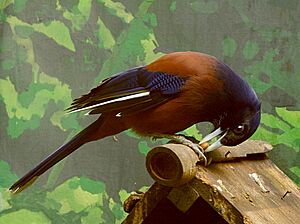Lidth's jay facts for kids
Quick facts for kids Lidth's jay |
|
|---|---|
 |
|
| In the Ueno Zoo, Japan | |
| Conservation status | |
| Scientific classification | |
| Genus: |
Garrulus
|
| Species: |
lidthi
|
The Lidth's jay (Garrulus lidthi), also known as the Amami jay, is a beautiful bird found only in Japan. It is a type of passerine bird, which means it's a perching bird. This special bird belongs to the Corvidae family, which includes crows and magpies.
Contents
About Lidth's Jay
Lidth's jay is a bit bigger than its cousin, the Eurasian jay. It can grow up to 38 centimeters (about 15 inches) long. This bird has a strong, thick beak and a long tail.
What Lidth's Jay Looks Like
This jay does not have a crest of feathers on its head. Its head feathers are a soft, velvety black. The feathers on its shoulders and back are a deep purplish-blue. All the other parts of its body are a rich chestnut-purple color. These bright colors make it stand out!
Where Lidth's Jay Lives
Lidth's jay lives in a very small area. You can only find it on two southern Japanese islands: Amami Ōshima and Tokunoshima. It likes to live in pine forests and warm, sub-tropical woodlands. You might also spot it in farm areas, especially near villages.
What Lidth's Jay Eats
This bird mainly eats the nuts from a native tree called the chinkapin (Castanopsis cuspidata). These nuts are like acorns. But Lidth's jay also enjoys eating small reptiles and many kinds of invertebrates, like insects.
Reproduction and Life Cycle
Lidth's jays build their nests inside large holes in trees. Their nests are similar to those of other Garrulus species. Female jays usually lay 3 to 4 eggs.
How Lidth's Jay Sounds
The sounds Lidth's jay makes are very much like those of the Eurasian jay.
Protecting Lidth's Jay
In the past, Lidth's jays were hunted for their beautiful feathers. These feathers were used to decorate ladies' hats. Today, the main danger to these birds comes from introduced animals.
The Threat of Mongooses
Small small Indian mongooses were brought to the islands where Lidth's jays live. They were meant to help control the venomous Okinawa pit viper. However, these mongooses also hunt Lidth's jays and their eggs.
Conservation Efforts
Luckily, Lidth's jay is now fully protected by Japanese law. Efforts to control the mongoose population have helped the jays. Because of these actions, the number of Lidth's jays is now growing!
Interesting Facts
The scientific name for this bird, lidthi, honors a Dutch zoologist named Theodoor Gerard van Lidth de Jeude. In 1965, the Lidth's jay was chosen as the official symbolic bird of Kagoshima Prefecture in Japan.


